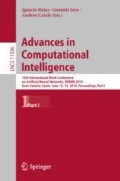Abstract
Alzheimer’s disease (AD) is classified as a chronic neurological disorder of the brain and affects approximately 25 million elderly individuals worldwide. This disorder leads to a reduction in people’s productivity and imposes restrictions on their daily lives. Studies of AD often rely on electroencephalogram (EEG) signals to provide information on the behavior of the brain. Recently, a map from a time series to a network has been proposed and that is based on the concept of transition probabilities; the series results in a so-called “quantile graph” (QG). Here, this map, which is also called the QG method, is applied for the automatic detection of healthy patients and patients with AD from recorded EEG signals. Our main goal is to illustrate how the differences in dynamics in the EEG signals are reflected in the topology of the corresponding QGs. Based on various network metrics, namely, the clustering coefficient, the mean jump length and the betweenness centrality, our results show that the QG method can be used as an effective tool for automated diagnosis of Alzheimer’s disease.
Access this chapter
Tax calculation will be finalised at checkout
Purchases are for personal use only
References
Acharya, U.R., Faust, O., Kannathal, N., Chua, T., Laxminarayan, S.: Non-linear analysis of EEG signals at various sleep stages. Comput. Meth. Programs Biomed. 80, 37–45 (2005)
Adeli, H., Ghosh-Dastidar, S., Dadmehr, N.: Alzheimer’s disease: models of computation and analysis of EEGs. Clin. EEG Neurosci. 36(3), 131–140 (2005)
Alotaiby, T.N., Alshebeili, S.A., Alshawi, T., Ahmad, I., El-samie, F.E.A.: EEG seizure detection and prediction algorithms: a survey. EURASIP J. Adv. Signal Process, p. 183 (2014)
Besthorn, C., et al.: Discrimination of Alzheimer’s disease and normal aging by EEG data. Electroencephalogr. Clin. Neurophysiol. 103(2), 241–248 (1997)
Budson, A., Solomon, P.: Memory Loss, Alzheimer’s Disease, and Dementia. Elsevier, New York (2015)
Campanharo, A.S.L.O., Doescher, E., Ramos, F.M.: Automated EEG signals analysis using quantile graphs. In: Rojas, I., Joya, G., Catala, A. (eds.) IWANN 2017. LNCS, vol. 10306, pp. 95–103. Springer, Cham (2017). https://doi.org/10.1007/978-3-319-59147-6_9
Campanharo, A.S.L.O., Doescher, E., Ramos, F.M.: Application of quantile graphs to the automated analysis of EEG signals. Neural Process. Lett., 1–16 (2018)
Campanharo, A.S.L.O., Ramos, F.M.: Distinguishing different dynamics in electroencephalographic time series through a complex network approach. In: Proceeding Series of the Brazilian Society of Applied and Computational Mathematics. vol. 5. SBMAC (2017)
Campanharo, A.S.L.O., Ramos, F.M.: Hurst exponent estimation of self-affine time series using quantile graphs. Physica A 444, 43–48 (2016)
Campanharo, A.S.L.O., Sirer, M.I., Malmgren, R.D., Ramos, F.M., Amaral, L.A.N.: Duality between time series and networks. PLoS ONE 6, e23378 (2011)
Costa, L.F., Rodrigues, F.A., Travieso, G., Villas, P.R.: Characterization of complex networks. Adv. Phys. 56, 167–242 (2007)
Feldman, H.H., Woodward, M.: The staging and assessment of moderate to severe Alzheimer disease. Neurology 65, S10–S17 (2005)
Freeman, L.C.: A set of measures of centrality based on betweenness. Sociometry 40, 35–41 (1977)
Hajian-Tilaki, K.: Receiver operating characteristic (ROC) curve analysis for medical diagnostic test evaluation. Caspian J. Intern. Med. 4, 627 (2013)
Kantz, H., Schreiber, T.: Nonlinear Time Series Analysis. Cambridge University Press, Cambridge (2003)
Korner, T.W.: Fourier Analysis. Cambridge University Press, Cambridge (1988)
Morris, A.S., Langari, R.: Measurement and Instrumentation. Academic Press, San Diego (2012)
Obuchowski, N.A., Bullen, J.: Receiver operating characteristic (ROC) curves: review of methods with applications in diagnostic medicine. Phys. Med. Biol. 63, 07TR01 (2018)
Organization, W.H.: Dementia: World Health Organization, Switzerland (2012)
Percival, D.B., Walden, A.: Wavelet Methods for Time Series Analysis. Cambridge University Press, Cambridge (2000)
Ridouh, A., Boutana, D., Bourennane, S.: EEG signals classification based on time frequency analysis. J. Circ. Syst. Comput. 26, 1750198 (2017)
Saramäki, J., Kivelä, M., Onnela, J.P., Kaski, K., Kertesz, J.: Generalizations of the clustering coefficient to weighted complex networks. Phys. Rev. E 75, 027105 (2007)
Stam, C., Jelles, B., Achtereekte, H., Van Birgelen, J., Slaets, J.: Diagnostic usefulness of linear and nonlinear quantitative EEG analysis in Alzheimer’s disease. Clin. Electroencephalogr. 27(2), 69–77 (1996)
Tsolaki, A., Kazis, D., Kompatsiaris, I., Kosmidou, V., Tsolaki, M.: Electroencephalogram and Alzheimer’s disease: clinical and research approaches. Int. J. Alzheimer’s Dis. 2014, 10 (2014)
Ubeyli, E.D.: Analysis of EEG signals by combining eigenvector methods and multiclass support vector machines. Comput. Biol. Med. 38, 14–22 (2011)
Ubeyli, E.D., Guler, I.: Features extracted by eigenvector methods for detecting variability of EEG signals. Comput. Biol. Med. 28, 592–603 (2007)
Yagneswaran, S., Baker, M., Petrosian, A.: Power frequency and wavelet characteristics in differentiating between normal and alzheimer EEG. In: Engineering in Medicine and Biology, 2002 24th Annual Conference and the Annual Fall Meeting of the Biomedical Engineering Society EMBS/BMES Conference, 2002 Proceedings of the Second Joint, vol. 1. IEEE (2002)
Zar, J.H.: Biostatistical Analysis. Prentice Hall, New Jersey (2010)
Zhang, Y., Liu, B., Ji, X., Huang, D.: Classification of EEG signals based on autoregressive model and wavelet packet decomposition. Neural Process. Lett. 45, 365–378 (2016)
Acknowledgments
A. M. P. acknowledges the support of Coordenação de Aperfeiçoamento de Pessoal de Nível Superior - Brasil (CAPES) - Finance Code 001. L. E. B. acknowledges the support of São Paulo Research Foundation (FAPESP), grant 2016/17914-3. A. S. L. O. C. acknowledges the support of São Paulo Research Foundation (FAPESP), grant 2018/25358-9. The authors would like to thank Dr. Dennis Duke of Florida State University for providing EEG data for this research project.
Author information
Authors and Affiliations
Corresponding author
Editor information
Editors and Affiliations
Rights and permissions
Copyright information
© 2019 Springer Nature Switzerland AG
About this paper
Cite this paper
Pineda, A.M., Ramos, F.M., Betting, L.E., Campanharo, A.S.L.O. (2019). Use of Complex Networks for the Automatic Detection and the Diagnosis of Alzheimer’s Disease. In: Rojas, I., Joya, G., Catala, A. (eds) Advances in Computational Intelligence. IWANN 2019. Lecture Notes in Computer Science(), vol 11506. Springer, Cham. https://doi.org/10.1007/978-3-030-20521-8_10
Download citation
DOI: https://doi.org/10.1007/978-3-030-20521-8_10
Published:
Publisher Name: Springer, Cham
Print ISBN: 978-3-030-20520-1
Online ISBN: 978-3-030-20521-8
eBook Packages: Computer ScienceComputer Science (R0)

